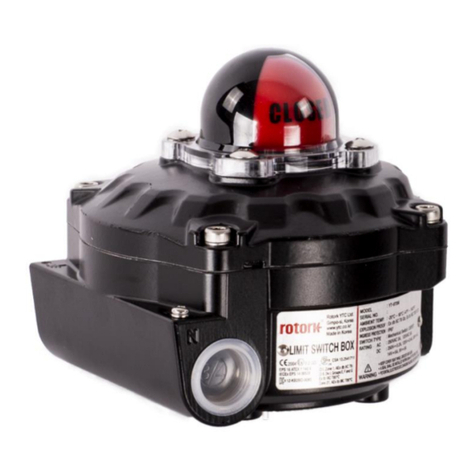
3
1. Specification of the safety functions
The safety function is of 2 types:
Type A – Switches
The device is classified Type A according to IEC 61508-2.
The safety function is defined as follows:
1. De-energize-to-trip operation: when the actuator,
on which the device is mounted, starts to drive the
emergency valve to its safe position.
2. De-energize-to-trip operation: when the actuator, on
which the device is mounted, reaches the “safe position”.
NOTES:
the above-mentioned safety functions can be
considered equivalent. In both cases, the safety function
shall correspond to the situation in which the switches pass
from “operating position” to “released position”, i.e. the limit
switch box, when used with safety function, shall work in
“deenergize-to-trip” mode, and shall be configured in that
way to perform the safety function.
The response time for the activation of the safety function is
less than 10 ms.
The choice of the safety function to be implemented is
responsibility of the system integrator.
Type B – Position Transmitters
(available for models SS, SF, SB, HW, SX, SW, SY, SH, SI)
The device is classified Type B according to IEC 61508-2.
The safety function is defined as follows:
1. Correct measuring of the position of the actuator on
which the device is mounted (normally angular position),
and generation of 4-20 mA output signal proportional to
the position, within ±2 % of tolerance.
The product has normally a single channel configuration
(only one input is measured, only one current output is
generated), with HFT=0.
A redundant (1oo2) configuration can be obtained in
these ways:
•
with one single micro switch box, internally completely
redundant (2 potentiometers, 2 position transmitters,
2 separate outputs)
•
with two micro switch boxes, each one internally in single
channel configuration
In both cases, the two analog outputs shall be voted 1oo2 by
the downstream controller.
The minimum response time is the following (in case no
digital filter is applied).
•
with position transmitters Siemens TH320/420 and PR
electronics 5437D: ≤ 75 ms
•
with position transmitters Siemens TH300: ≤ 250 ms
NOTE:
In the following paragraphs, a distinction between
Type A and Type B is used, where necessary.
The IEC 61508 standard describes a package of general
requirements for every phase of the lifecycle of safety
systems. The reliability analysis performed has shown that
these products are suitable for use in such systems for
safety class SIL 2 or SIL 3 according to switch options and
barriers used.
For installation, maintenance, test and commissioning of
these rotary switch boxes, the documents prescribed by
the IEC 61508 standard should be used. Depending on the
determined SIL class, they also prescribe the required measure
of authority, skills and independence of the concerning
personal. All indications and prescriptions within the
subjoined general installation and maintenance instructions
are the basis for these above mentioned documents. In order
to warrant the reliability, the supplemental prescriptions
mentioned below, should be observed as well.
•
Suitably trained personnel shall carry out installation in
accordance with applicable code of practice
•
The user should not repair this equipment
•
If the equipment is likely to come into contact with
aggressive substances, it is the responsibility of the
user to take suitable precautions that prevent it from
being adversely affected, thus ensuring that the type of
protection is not compromised
Aggressive substances – ex. Acidic liquids or gases that
may attack the switch box housing
•
The electrical ratings on nameplates or on adhesive
labels on the enclosure must be respected, otherwise the
product’s SIL grade will not be guaranteed
•
PEPPERL & FUCHS SIL certified barriers must be used
in conjunction of the correct P+F proximity switches as
described in PEPPERL & FUCHS documentations for SIL
applications
•
Operational testing shall be performed according to the
following indications
•
Maximum applicable voltage: 24 Volt DC. Line
monitoring system works only if terminals 1-2 and
4-5 (normally closed) or 2-3 and 5-6 (normally open)
are connected; don’t connect contemporary normally
open and normally closed
•
This safety manual has to be used in conjunction with
the safety manual the position transmitter included in
the device: Siemens TH320/420 (par. 4, 14 and 15),
or Siemens TH300 (par. 7), or PR Electronics 5437D
(par. 7, 17 and 18)
2. Warnings
A4US
US
A4
US A4
US
A4
A4 US
US
A4
US
A4
A4 US





























